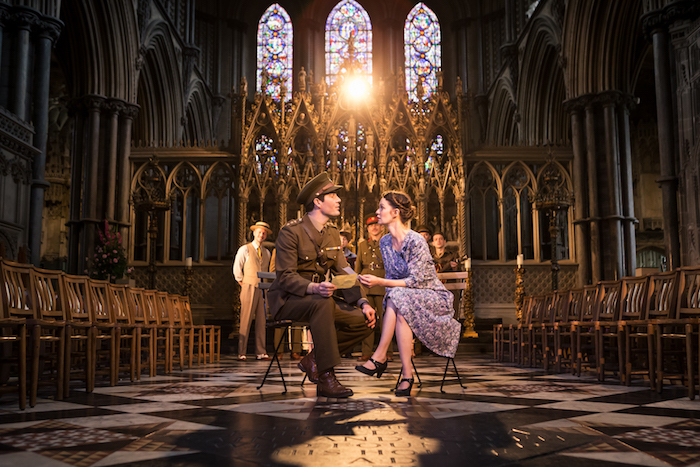Review: MUCH ADO ABOUT NOTHING, Gray's Inn Hall

![]() The will-they-won't-they trope of the Beatrice/Benedick relationship in Much Ado About Nothing is so familiar to audiences that, even though it's staged repeatedly (the last time this reviewer saw it was at Shakespeare's Globe in March), the joy in watching it again is to see how much sparkle a new production can bring to the witty wordplay (these days that's called banter) of the warring lovers in Shakespeare's sunniest comedy.
The will-they-won't-they trope of the Beatrice/Benedick relationship in Much Ado About Nothing is so familiar to audiences that, even though it's staged repeatedly (the last time this reviewer saw it was at Shakespeare's Globe in March), the joy in watching it again is to see how much sparkle a new production can bring to the witty wordplay (these days that's called banter) of the warring lovers in Shakespeare's sunniest comedy.
That effervescence is more than abundant in the award-winning Antic Disposition's interpretation of the play during its UK Cathedral tour, which culminates here, within the vaulted interior and acoustically resonant Gray's Inn Hall.
Antic Disposition specialises in presenting classic plays and stories in historic buildings and unusual non-theatre spaces. In this instance, it has enabled many of the people attending the show to discover a self-contained and hidden part of London's rich history.
Although 'cathedral' is a bit of a misnomer, Gray's Inn Hall has its own specific legacy of grandeur. It's fitting also that this production should end its tour here, as it's a coming home of sorts. Gray's Inn is one of the few remaining original Shakespearean venues in London - The Comedy of Errors was staged here in 1594.
Antic Disposition's Much Ado is ingeniously transposed to a village in rural France in the immediate aftermath of World War II, which effectively renders the layers of socio-cultural commentary inherent in Shakespeare's plot into real world events.
The audience enters the space to the sound of "La Vie en Rose" played on the accordion, and red check-covered tables in a cafe-style set-up that makes the first row so much a part of the action that at one point, Beatrice ends up in one of its member's laps.
Set in a village square called Place de Messina and borrowing heavily from the physical comedy of Jacques Tati films, it features an 11-strong, Anglo-French cast. This in itself is something of a novelty - it isn't often that one gets to hear Elizabethan English rendered in a French accent with a contemporary diction.
The cast makes it sound easy to do and, as a whole, is very impressive and multi-talented, with many of the members doubling as minor characters and as singers and musicians on accordion, guitar, flute and violin.
Inevitably, all eyes are on the two leads, and right from the off, in the parry and riposte of cleverly worded insults they heap on each other, there is an obvious and palpable chemistry between the actors playing them. Nicholas Osmond's Benedick is nuanced in his range of emotional expression, investing his lines with precision of intention.
Although Chiraz Aïch's Beatrice has an ease with the rhythm of Shakespeare's intricate lines, her no-nonsense performance stands out but not for entirely desirable reasons. Shakespeare didn't write Beatrice as a come-hither siren and it's right that she is played with the forthrightness that Aïch invests in her.
However, Aïch also plays her with a bluntness that doesn't match Osmond's degree of nuance, and sometimes that forcefulness veers a tad towards a shouty delivery that makes it difficult to understand individual lines.
Ben Horslen and John Riseboro direction/design makes great use of the entirety of the playing space, and their decision to replace some of the more difficult to understand Elizabethan humour with physical comedy is a very canny choice. While this is very effective in engaging the audience in more laughter, it stops just shy of tipping over into tedious repetitiveness.
This is complemented by a French tricolour bunting-themed set design, where cafe umbrellas double up as hiding places, and Lizzy Gunby's lighting, which utilises various tones of yellow. It's a simple colour palette, but the ambers, lemons, butters and creams are very powerful in conveying change of scene (in combination with music), time of day and passing of time.
Despite the small missteps here and there, Antic Disposition's Much Ado About Nothing is refreshingly fizzy and a lot of fun to watch.
Much Ado About Nothing at Gray's Inn Hall until 1 September
Photo credit: Scott Rylander
Reader Reviews
Videos

